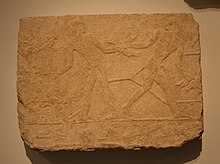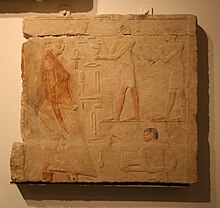Mastaba of Seschemnefer IV.
The mastaba of Seschemnefer IV. (LG 53) is located in the south cemetery of the necropolis of Giza . It was made around 2340 BC. It was built for the civil servant Seschemnefer IV. And is an example of the multi-room tombs that arose at the transition from the 5th to the 6th dynasty .
Find history
The mastaba was exposed for the first time between 1842 and 1845 by members of the Prussian expedition led by Karl Richard Lepsius . At that time, the reliefs were in a much better state of preservation. While Lepsius took decorative pieces from the north, south and east walls with him to Berlin ( Egyptian Museum Berlin inv. No. 1128 to 1130 and 1318), the blocks on the west wall remained in place until Hermann Junker was excavated . The tomb was completely uncovered by Junker during the excavation campaign in 1928/29. Various relief fragments and other parts of the grave equipment ended up in the Egyptian collection of the Roemer and Pelizaeus Museum in Hildesheim as part of a finding .
Grave owner
Seschemnefer IV. ( Sšm-nfr ) was "head of the royal Harim", that is, he was the administrative director of the palace area, in which the women and children of the royal family lived. In addition, his title contains rank and honorary titles that identify him as an important man at the court who had the confidence of his ruler. The relief representations still preserved from this mastaba give the viewer an insight into everyday life at that time; in the rural field work, cattle breeding, bird trapping, the granaries, over the work clothes, the sacrificial rituals and partly also in the colloquial language.
Representations
Goats playing (Inv.No. PM 3192)
The discarded relief fragment can no longer be assigned to any wall of the mastaba. In the upper register it shows a billy goat and a jumping young animal, in the lower register a billy goat jumping over a goat. Behind it is another jumping cub. So it's a scene from everyday rural life.
Bird catching scene (Inv.No. PM 3193)
This fragment, too, cannot be clearly assigned to a wall in the mastaba of Seschemnefer IV. It shows the safety net and the transfer of captured birds between two people. Two men are shown in a bird-catching scene. The one on the left is called the "chief of bird trapping". The inscription in front of the second man, which has only been preserved in fragments, says: "Arrange for the net to be drawn". The man signals that the safety net with the birds that have flown into it should be pulled shut. The two birds on the right have escaped capture. In the top row of the illustration, three men are about to empty the safety net. The man on the right takes out the birds and passes them to the man in front. He then passes it on to the third man standing by a cage, of whom only his hands have been preserved. There are already several captured birds in the cage.
Large harvest display (Inv.No. PM 3191)
Depictions of various areas of agriculture such as this fragment of relief with its two and a half preserved registers of a harvest scene were regularly part of the pictorial program of large grave complexes. The three block fragments were recovered from the right part of the west wall. The left wall area is lost and bore a representation of the grave lord, which was preserved up to the height of the belt when it was first found. This fragment of a harvest illustration can be supplemented as follows: On the left stood Seschemnefer IV, in front of him flax and grain were harvested. The cutting of the grain with hand sickles, which is controlled by a guard on the right, is still preserved here. Below that the transport of the grain to the threshing floor is shown. The sheaves are in the large sacks carried by donkeys. Then on the right, two workers lay up the sheaves on the threshing floor, as the accompanying inscription indicates. The donkey drivers hold the sacks with their hands. In the upper register, the agricultural scenes are hardly preserved. On the other wall of the same room, the work steps that followed the work described were shown: the threshing with the donkeys and the winnowing. All of these representations give the grave lord a guarantee of physical supplies after his death. They kept him from hunger and thirst forever and ever. The relief is made of limestone and is 84.5 cm high, 100.5 cm wide and 10.5 cm deep.
Throwing down a bull (Inv.No. PM 3194)
This relief block belonged to the topmost of the three picture strips of the right door reveal of a passage between two rooms. Shackled and thrown down a slaughtered animal is shown. One man grabs the bull by the horns, while another pulls its front legs away with a rope and at the same time pushes its hind legs away with his foot to make him fall. The inscription says that it is a young sacrificial cattle.
Sacrifice in front of the statue of Seschemnefer IV. (Inv. No. PM 3190)
In the foreground of this smoking and beef offering scene is the statue of the grave lord Seschemnefer IV, who is depicted as a stately, corpulent, upright, particularly dignified-looking man. The representation of the shoulder and the arm position in profile show that it is a statue. Otherwise, in Egyptian portrayals of people, the shoulders are always shown from the front, the head in profile . It is designated as the statue of the "only friend - Seschemnefer" ( twt-r-ˁnch Smḥr-w ˁ.tj sSm-nfr ). Facing the statue are three servants (priests of the dead) who are shown smaller. In the upper part of the relief, the caretaker Mer-r-ri ( jmj-r3 pr mrrj ) , who acts as the priest of the dead, lifts the lid of the censer so that the scent of the incense can reach the statue's nose. A second servant stands behind him. Due to the strong surface destruction, the papyrus that he is holding in his hand and from which he is reciting is no longer recognizable today. Underneath, another servant carries a beef thigh, which probably belongs to a slaughtering scene. Presumably these scenes continued. All of the people shown wear a short apron tied under their navel. With the help of his statue, which was magically enlivened by sacrifices and rituals , Seschemnefer IV wanted to live on. The statue served as his replacement body for the ages. The relief fragment is made of limestone, is 70.3 cm high, 78.3 cm wide and 10 cm deep.
literature
- Hermann Junker (Ed.): Gîza XI. The cemetery south of the Great Pyramid. Eastern part . Report on the work carried out by the Academy of Sciences in Vienna at joint expense with Dr. Wilhelm Pelizaeus † undertook excavations in the cemetery of the Old Kingdom near the pyramids of Gîza (= Austrian Academy of Sciences. Philosophical-historical class. Memoranda . Volume 74.2 ). Rohrer, Vienna 1953, p. 92-96, 100-119, 126-131, 137-241 ( gizapyramids.org [PDF; 85.3 MB ] Figures 49–55, 60–95, plates I, XI – XXIV).
- Hans Kayser : The Pelizaeus Museum in Hildesheim . Cram, de Gruyter, Hamburg 1966, p. 23–24 and 44 (Figure 8. Relief from the grave of Seschemnofer depicting a harvest scene).
- Hans Kayser: The Egyptian antiquities in the Roemer-Pelizaeus-Museum in Hildesheim. Gerstenberg, Hildesheim 1973, ISBN 3-8067-8002-1 , pp. 16, 41–42, 50 (3190) Relief from the grave of "Count" Seschemnofer with the depiction of a sacrifice in front of the statue of the grave owner, (3191) Limestone relief ... with harvest scenes, (3192) fragment of relief ... depicting grazing goats, (3193) fragment of relief ... depicting bird trapping, (3194) relief from a chamber of the family grave of "Count" Seschemnofer, (3270 ) Fragment depicting three hyena heads staggered one behind the other and images of the 12th harvest scene, 13th goats playing.
- Bertha Porter , Rosalind LB Moss : Topographical Bibliography of Ancient Egyptian Hieroglyphic Texts, Reliefs, and Paintings. III. Memphis. Part I. (Abû Rawâsh to Abûṣîr) . 2nd edition, revised and expanded by Jaromír Málek . The Clarendon Press, Oxford 1974, pp. 223–227 ( gizapyramids.org [PDF; 31.0 MB ]).
- Arne Eggebrecht (ed.): The old empire. Egypt in the age of the pyramids. von Zabern, Mainz 1986, ISBN 3-8053-0936-8 .
- Bettina Schmitz : "... digging the pyramids, hopefully with success!" Giza, the Old Kingdom in Hildesheim . In: Katja Lembke (Hrsg.): Das Alte Reich. Egypt from the beginnings to high culture (= Ancient Egypt in Hildesheim ). tape 1 . von Zabern, Mainz 2009, ISBN 978-3-8053-4073-1 , p. 18 (catalog for the permanent exhibition).
- Martin von Falck: From the beginning to high culture. The way of Egypt in the 4th and 3rd millennium BC Chr. In: Katja Lembke (Hrsg.): Das Alte Reich. Egypt from the beginnings to high culture . S. 43-45 .
- Martin von Falck: Relief blocks with harvest scenes from the grave of Seschem-nefer IV, relief with sacrificial rites in front of the statue of Seschem-nefer IV . In: Katja Lembke (Hrsg.): Das Alte Reich. Egypt from the beginnings to high culture . S. 86-89 .
Web links
- The mastaba of Seschemnefer IV. In the Giza project
- The mastaba of Seschemnefer IV. In the Giza archive
- Klaus Finneiser: In fields and pastures . Grave relief of Seschem-nefer IV from the Old Kingdom (Berlin, Egyptian Museum Inv.No. 1129)
Individual evidence
- ↑ H. Junker: Giza XI. The cemetery south of the Great Pyramid. Eastern part. Vienna 1953, p. 234, Figure 91, Plate XXIVa.
- ↑ H. Junker: Giza XI. The cemetery south of the Great Pyramid. Eastern part. Vienna 1953, p. 187, Figure 74a, Plate XXId.
- ↑ H. Junker: Giza XI. The cemetery south of the Great Pyramid. Eastern part. Vienna 1953, p. 205, Figure 79, panel XXd.
- ↑ H. Junker: Giza XI. The cemetery south of the Great Pyramid. Eastern part. Vienna 1953, p. 226, Figure 89, plates XXIIIa and XXIIIb.





